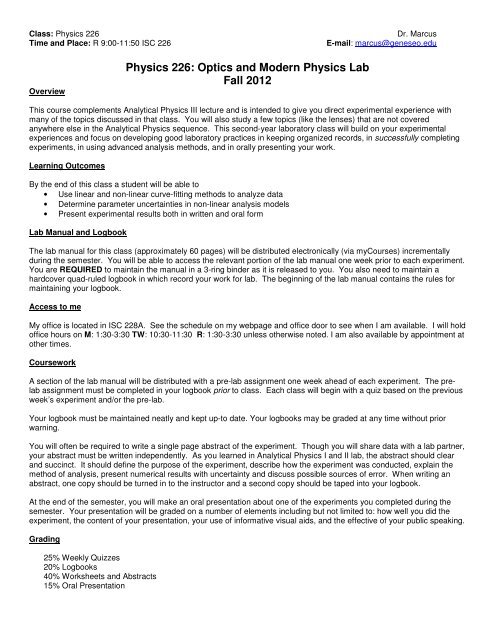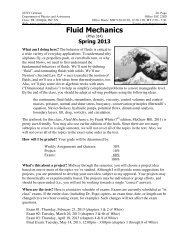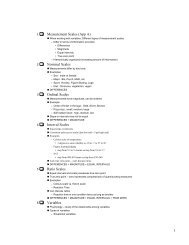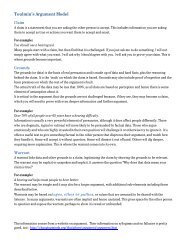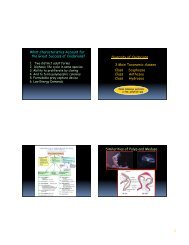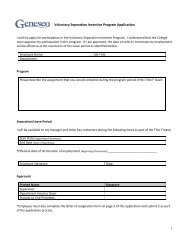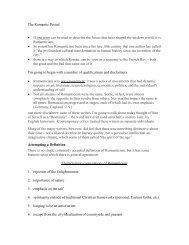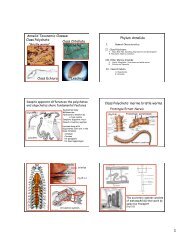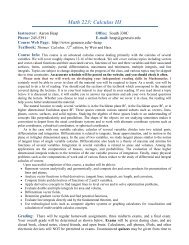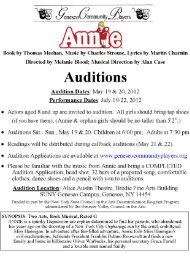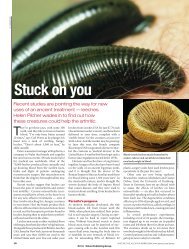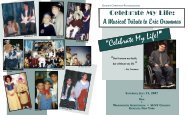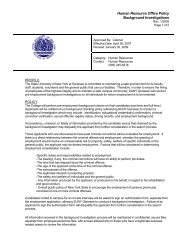Physics 226: Optics and Modern Physics Lab Fall 2012
Physics 226: Optics and Modern Physics Lab Fall 2012
Physics 226: Optics and Modern Physics Lab Fall 2012
You also want an ePaper? Increase the reach of your titles
YUMPU automatically turns print PDFs into web optimized ePapers that Google loves.
Class: <strong>Physics</strong> <strong>226</strong><br />
Time <strong>and</strong> Place: R 9:00-11:50 ISC <strong>226</strong><br />
Dr. Marcus<br />
E-mail: marcus@geneseo.edu<br />
Overview<br />
<strong>Physics</strong> <strong>226</strong>: <strong>Optics</strong> <strong>and</strong> <strong>Modern</strong> <strong>Physics</strong> <strong>Lab</strong><br />
<strong>Fall</strong> <strong>2012</strong><br />
This course complements Analytical <strong>Physics</strong> III lecture <strong>and</strong> is intended to give you direct experimental experience with<br />
many of the topics discussed in that class. You will also study a few topics (like the lenses) that are not covered<br />
anywhere else in the Analytical <strong>Physics</strong> sequence. This second-year laboratory class will build on your experimental<br />
experiences <strong>and</strong> focus on developing good laboratory practices in keeping organized records, in successfully completing<br />
experiments, in using advanced analysis methods, <strong>and</strong> in orally presenting your work.<br />
Learning Outcomes<br />
By the end of this class a student will be able to<br />
• Use linear <strong>and</strong> non-linear curve-fitting methods to analyze data<br />
• Determine parameter uncertainties in non-linear analysis models<br />
• Present experimental results both in written <strong>and</strong> oral form<br />
<strong>Lab</strong> Manual <strong>and</strong> Logbook<br />
The lab manual for this class (approximately 60 pages) will be distributed electronically (via myCourses) incrementally<br />
during the semester. You will be able to access the relevant portion of the lab manual one week prior to each experiment.<br />
You are REQUIRED to maintain the manual in a 3-ring binder as it is released to you. You also need to maintain a<br />
hardcover quad-ruled logbook in which record your work for lab. The beginning of the lab manual contains the rules for<br />
maintaining your logbook.<br />
Access to me<br />
My office is located in ISC 228A. See the schedule on my webpage <strong>and</strong> office door to see when I am available. I will hold<br />
office hours on M: 1:30-3:30 TW: 10:30-11:30 R: 1:30-3:30 unless otherwise noted. I am also available by appointment at<br />
other times.<br />
Coursework<br />
A section of the lab manual will be distributed with a pre-lab assignment one week ahead of each experiment. The prelab<br />
assignment must be completed in your logbook prior to class. Each class will begin with a quiz based on the previous<br />
week’s experiment <strong>and</strong>/or the pre-lab.<br />
Your logbook must be maintained neatly <strong>and</strong> kept up-to date. Your logbooks may be graded at any time without prior<br />
warning.<br />
You will often be required to write a single page abstract of the experiment. Though you will share data with a lab partner,<br />
your abstract must be written independently. As you learned in Analytical <strong>Physics</strong> I <strong>and</strong> II lab, the abstract should clear<br />
<strong>and</strong> succinct. It should define the purpose of the experiment, describe how the experiment was conducted, explain the<br />
method of analysis, present numerical results with uncertainty <strong>and</strong> discuss possible sources of error. When writing an<br />
abstract, one copy should be turned in to the instructor <strong>and</strong> a second copy should be taped into your logbook.<br />
At the end of the semester, you will make an oral presentation about one of the experiments you completed during the<br />
semester. Your presentation will be graded on a number of elements including but not limited to: how well you did the<br />
experiment, the content of your presentation, your use of informative visual aids, <strong>and</strong> the effective of your public speaking.<br />
Grading<br />
25% Weekly Quizzes<br />
20% Logbooks<br />
40% Worksheets <strong>and</strong> Abstracts<br />
15% Oral Presentation
Class: <strong>Physics</strong> <strong>226</strong><br />
Time <strong>and</strong> Place: R 9:00-11:50 ISC <strong>226</strong><br />
Dr. Marcus<br />
E-mail: marcus@geneseo.edu<br />
Schedule of Experiments<br />
<strong>Lab</strong> 0: Introduction Aug 28 – Aug 31<br />
<strong>Lab</strong> 1: Index of Refraction of Glass/Lenses Sep 4 – Sep 7<br />
<strong>Lab</strong> 2: Permittivity of Free Space Sep 11 – Sep 14<br />
<strong>Lab</strong> 3: Polarization of Light Sep 18 – Sep 21<br />
<strong>Lab</strong> 4: Ultrasonic Interference <strong>and</strong> Diffraction Sep 25 – Sep 28<br />
Oct 2 – Oct 5<br />
<strong>Fall</strong> Break – no labs this week Oct 8 – Oct 9<br />
<strong>Lab</strong> 5: The Speed of Light Oct 16 – Oct 19<br />
Oct 23 – Oct 26<br />
<strong>Lab</strong> 6: The Bohr Atom Oct 30 – Nov 2<br />
<strong>Lab</strong> 7: The Michelson Interferometer Nov 6 – Nov 9<br />
<strong>Lab</strong> 8: Blackbody Radiation Nov 13 – Nov 16<br />
Thanksgiving Break – no labs this week Nov 19 – Nov 23<br />
<strong>Lab</strong> 9: Photoelectric Effect Nov 27 – Nov 30<br />
<strong>Lab</strong> 10: Chaos – Computer Simulation Dec 4 – Dec 7<br />
Oral Presentations<br />
Section 1 (Tuesdays)<br />
Monday, Dec 17, 3:30 pm<br />
Section 2 (Wednesday) Monday, Dec 17, 12:00 pm<br />
Section 3 (Thursdays)<br />
Section 4 (Fridays)<br />
Thursday, Dec 13, 8:00 am<br />
Wednesday, Dec 12, 12:00 pm<br />
You will work with a different lab partner each week. Your assigned lab partners are listed on<br />
myCourses. To determine your lab partner(s) for any experiment, find the row corresponding to<br />
your name, <strong>and</strong> then scan across until you find the number of the lab you are performing (as<br />
listed above). The name above this number is your partner. If an experiment number is<br />
colored pink, then you will make an oral presentation on your work for that experiment on<br />
December 13.


